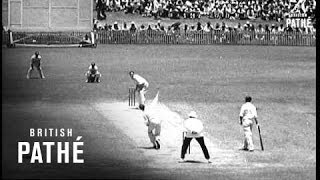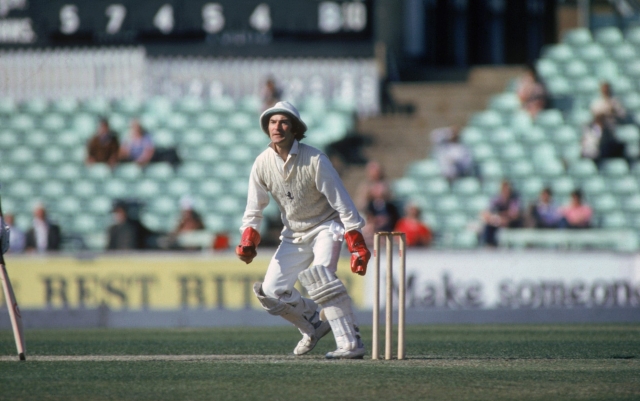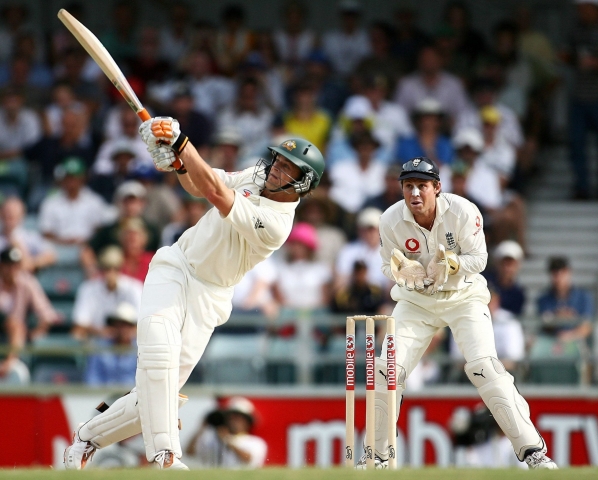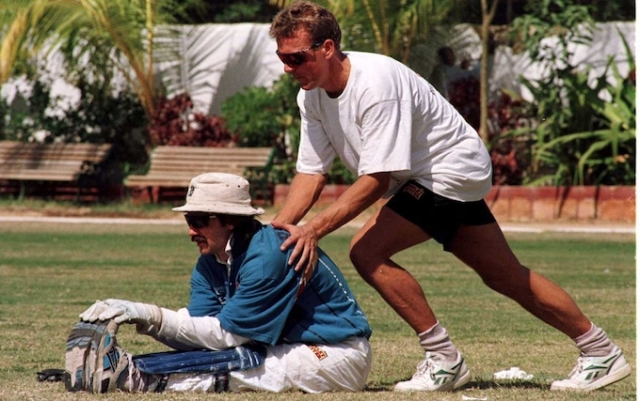Alec Stewart's punch gave him the advantage over Jack Russell, but he sympathized with the plight of his opponent. Photo: Russell Boyes REUTERS
In England's last Test match, Ben Fawkes showed his wicket-handling at his best.
In the 152nd over of New Zealand's second innings at Wellington, Kane Williamson took a splinter of sharp an edge so thin the referee didn't notice, but Fawkes caught it and convinced Ben Stokes to reconsider. he went back for a run; Fawkes noticed that the bat was not grounded and was released from bail.
Bracewell's lazy run, now sitting in the barn.
FOLLOW #NZvENG LIVE:
👉https://t.co/15hBMuWc81👈 pic.twitter.com/EScEHI6xok
— 🏏Flashscore Cricket Commentators (@FlashCric) February 27, 2023 < p>Head coach Brandon McCallum said Fawkes even had Daryl Mitchell beat bouncer Stuart Broad: “He went to the stumps to influence the game and got the wicket." Thus, two, and perhaps even three wickets on an obedient field bore the stamp of Fawkes' creativity, ingenuity and skill.
And yet for Foaks this is still not enough. He is replaced on the Test squad by Johnny Bairstow, who spent six Test centuries as a batsman in 2022 and is believed in England to offer more runs as the number 7 batsman.
Pick the best wicket or batsman most likely to score the most points? This is a new discussion, but also a very old one. And it is one that is laced with a cultural as well as cricket dimension. Defending a professional goalkeeper is not just a cricket argument; it's also, on some level, a nostalgic argument for an era when teams actually chose their best goalkeeper. Except, of course, that it's rarely been that easy.
'If only Ames could hold like Duckworth, or Duckworth could punch like Ames'
In September 1928, England sailed for the Ashes. tour of Australia. On board the SS Otranto, George Duckworth told Les Ames, “Only one wicket-keeper can play in each of the trials, and that means you or I… It depends on who isn't chosen to help the other.” in every way"
When the team arrived in Australia, P. G. Fender, captain of Surrey, who was covering the tour as a journalist, wrote: “I found everyone deploring that Ames couldn't hold up like Duckworth, or that Duckworth couldn't hit, like Ames, but there were no two opinions, up to this stage, regarding Duckworth's great ability as a wicket.”
As 93 years later, the identity of the England goalkeeper was constantly discussed in the run-up to the Ashes. And, as now, there was a certain clarity in the debate: one would expect one candidate to offer more behind the stumps, another in front of them.
In the early years of Test cricket, the wicket was the preserve of specialists. “Sticky gates”, when the field dried up after being left open in the rain, behaved erratically; Standing up to spinners in such conditions required profound skill, especially without helmets or even adequate gloves to provide protection. Jack Blackham, the Australian goalkeeper who played in the first Test match in 1877, gave a simple piece of advice to would-be goalkeepers: “Drop it and go bowling.” ball after ball in an era of high odds meant that choosing goalkeepers partly to bat them was seen as a risk that could compromise their core skill.
The conventional wisdom is that sides should choose the best goaltender and then worry about where they bat. Herbert Strudwick played 28 Tests for England from 1910–26; he averaged 7.9 points, with more than half of them in 11th place.
In keeping with these traditions, Duckworth was selected in all five Ashes tests in 1928/29. The decision was confirmed by England's 4-1 series victory; Duckworth made 13 catches and one dead end. But for all his batsmanship, Duckworth often batted at age 11 for England; he averaged 14.6 in his 24 Tests, finishing last in nine Tests.
These restrictions led Duckworth to eventually become the England goalkeeper. Ames, as Fender wrote, was universally recognized as the lowest Duckworth behind the stumps. But he opened up new opportunities for them.
In the summer following the Ashes victory tour, Ames made his Test debut. He hit #8 and ducked. The following winter, Ames earned two centuries out of five, doubling the total hundreds scored by all Test keepers during a 1–1 draw in the West Indies. It was the prelude to a remarkable Testing career: Ames scored eight centuries remaining and averaged 40.6. He ran not only with unparalleled reliability for a goalkeeper, but also with speed, driving in style across the infield: Ames won the Walter Lawrence Trophy twice, for the fastest century in the English summer.
Nobody ever praised. Ames as equal to Duckworth behind the stumps – he allowed four more times in the Test – but he became a reliable goalkeeper and made England a more balanced team.
In 1952, the first edition of the MCC Cricket Coaches' Book proclaimed: as an absolute principle in the selection of teams, that the best goalkeeper should always be chosen, regardless of all other considerations… "
But a generation earlier, England already believed that they did not always get the most benefit by choosing the best goalkeeper. Since then, the debate about whether they should do so has seldom stopped.
“Wickets are very rarely chosen for England unless they know how to bat”
When Ames took his last test in 1939, he won eight out of 11 centuries in tests. After his retirement, Ames began to look less like a harbinger of what was to come, and more like an exceptional case. In the 1950s, all goalkeepers averaged just 20.6 points in tests, just one more try than in the 1920s.
Godfrey Evans, who played 91 Tests for England between 1946 and 1959, averaged almost exactly the same figure: a significant jump over Stroudwick and Duckworth, but only twice that of Ames. In Ashes 1954/55, Evans averaged only 17, but did one of the runs. most significant contribution. On the fifth morning in Melbourne, with the series tied at 1–1, Australia needed another 165 runs to win with eight wickets in hand. Neil Harvey, the great Australian batsman, was on the verge of having Frank Tyson out of the series as quickly as possibly any England bowler in Test history. Tyson's In The Eye of the Typhoon tour diary continues the story:
When the left-hander looked at the bat in its entirety, he must have thought it was some kind of four. But he left out goalkeeper Godfrey Evans, who danced a few steps to the right and rushed towards the ball like a circus acrobat. He collected the most incredible wicket catch I've ever seen, right in front of Colin Cowdrey, who was playing very far off the field on a foot slide! It was a catch that changed the course of the game – perhaps the series.

The moment was the start of one of the best spells in English Test history: a six out of 16 to give Tyson a seven out of 27 and secure a crushing victory for England. “He started so many things,” Tyson wrote of Evans. “In the all-important department of the wicket, England had a real winner.” After missing the opening Test due to sunstroke, Evans played in the next four; England won the toss, taking the series 4-1. Captain Len Hutton said the “bowlers have the utmost confidence” in Evans for the stumps.
Evans is considered by some to be the best goaltender of all time; Once England missed 1054 runs on the pitch and he didn't give a single goodbye. He had five wicket-driving principles, as he wrote in “Gloves Off”: “Good vision, balance, concentration, no dash, body behind the ball.” Keepers, as Evans explained, “do the job in a split second behind the stumps.”
Nevertheless, Evans' hero turned out to be indicative: Ames, his fellow Kent goalkeeper. “I admired and wanted to emulate his punch, his unorthodoxity, his unwavering drive to attack, the alternation of fours with odd sixes,” Evans wrote. The realization that he will not be able to match Ames returns – he won seven first-class centuries; Ames scored 102 points – this spurred Evans to develop his throw. “If I played for Kent at all, I would have to do something outstanding, even spectacular; so instead of retreating like most gatekeepers do, I stood up to everything, fast or slow, and depended on speed, agility, and relentless concentration to get through me.”
 Godfrey Evans may not have emulated his hero Les Ames with a bat, but with gloves, he is considered by some to be England's best goalkeeper. Photo: Jim James ?PA
Godfrey Evans may not have emulated his hero Les Ames with a bat, but with gloves, he is considered by some to be England's best goalkeeper. Photo: Jim James ?PA
In the 1950s, Pakistan's Imtiaz Ahmed and South Africa's John Waite averaged just over 30 points while keeping the game. But when goalkeepers could hit with a reach that equaled or even surpassed Ames, they tended not to be goalkeepers. Clyde Walcott of the West Indies averaged 40.4, retaining his first 15 tests. Due in part to a back problem, Walcott then became a batsman, a decision that was strongly confirmed as he averaged 64.7 without gloves. For all his genius as a goaltender and batsman, Walcott eventually reinforced the belief that top batsmen shouldn't be burdened with gloves.
It is possible to single out the moment when the test wicket was first made from a non-specialist. In 1960, Jim Parkes was called in as a replacement for England's tour of the West Indies. Parks had his first test as a specialist bat six years earlier. In 1958, at the age of 26, Parkes became the emergency goalkeeper for Sussex; he enjoyed the job so much that he persisted and then did so for England as well, averaging 32.2 points in his 46 Test matches. Parks has effectively usurped John Murray, the top goaltender who is averaging 10 fewer runs in tests.
In 1965, Alan Knott, having just finished his first first-class season when he showed his propensity for diving, fishing with one hand but averaging only 13.3, toured the Caribbean with the International Cavaliers. There, West Indian wicket-keeper Jackie Hendrix offered some advice, as Knott related: “Wickets are very rarely picked for England unless they know how to bat. This remark stuck in my head and remembered well. Knott represented a new type of test wicket—a true specialist who also averaged 32.8 at bat. He needed to play 95 tests; most considered Bob Taylor to be an even better gloved player, but he only scored 16.3 in Tests and had to wait until Knott signed Kerry Packer for the World Series of Cricket to enjoy his tenure as first choice.
 Alan Knott kept Bob Taylor on the sidelines for 10 years starting in 1967 and took the gloves back from the WSC. in a test game as expectations for how much the batsmen would contribute increased. Test cricket goalkeepers averaged 27.3 points in the 1990s.
Alan Knott kept Bob Taylor on the sidelines for 10 years starting in 1967 and took the gloves back from the WSC. in a test game as expectations for how much the batsmen would contribute increased. Test cricket goalkeepers averaged 27.3 points in the 1990s.
For England, this decade was marked by perpetual debate: should Jack Russell or Alec Stewart leave the wicket? The couple were born five months apart in 1963. Russell was the preeminent English goaltender of his generation, especially adept at taking on medium-speed bowlers and a daring batsman. Stewart, like Ames before him, also became an excellent goalkeeper. He excelled as a batsman, averaging 46.7, but played 82 of his 133 tests as a batsman when he averaged a still very useful 34.9.
In 1991 at the Testa in Adelaide, after Russell landed a striking kick while standing against Gladstone Small's seamer, Russell was thrown off. “If the bowlers and batters did their job as well as Jack did, there would be no need to hand me gloves,” Stewart writes in his autobiography. “I felt so sorry for Jack.” This was the beginning of a trend towards Russell being constantly sacrificed and Stewart being forced out of his favorite starting position.
Curiously, one country has been largely immune to this trend: Australia. Prior to 1970, Australian goalkeepers averaged 17.9 points in Test cricket, five runs short of the average for other Test nations; As early as 1964, goalkeeper Wally Grout finished 11th in Australia in a Test. In 1972, during his country's 330th Test, Rod Marsh became the first Australian goalkeeper to win the Test's century. Marsh, according to Malcolm Knox in Watchmen, was the first Australian not to also be recognized as the best glove maker in his country. Never again will Australia tolerate a goalkeeper whose batting average is stuck in his teens.
1705 England v Australia Wicketers Question Mark
“You never know.” Thus, Australian Justin Langer saluted Adam Gilchrist as he went to battle in Hobart in his second Test in November 1999. Mushtaq.
“Those were his first words,” recalls Gilchrist. “I remember thinking, 'Wow, that's a positive attitude, but I'm not entirely sure I believe it.'
The next day, Gilchrist left with 149, almost out of the ball, after leading Australia to a four-wicket victory. This was hailed as the moment the wicket's expectations came true. the batting has been recalibrated permanently. In fact, the journey was already well advanced. Gilchrist embodied this shift and accelerated it.
“I'm very humbled when people say you changed the role of wicket batsmen, but that wasn't me,” he says. Gilchrist credits the influence of One Day International Cricket as the goalkeepers began to move up in order. His own path to the Australian Test team came through prosperity as a rookie for the ODI side. For this opportunity, Gilchrist had to thank Romesh Kaluvitaran, the militant goalkeeper for Sri Lanka when they won the 1996 World Cup. />
Ames and Walcott demonstrated what goalkeepers can achieve with the bat. So did engineer Faroh of India, who regularly opened the net during the game, Denis Lindsay of South Africa, who scored three centuries in five Tests against Australia in 1966/67, and Andy Flower of Zimbabwe, who averaged 53.7 points in 55 tests as a goalkeeper, with 12 hundreds. , 1990-2002 But no one matched the reliability of Gilchrist's scoring with his speed.
In the 2001 Ashes, England's meticulous head coach Duncan Fletcher had a notebook with brief notes on how to play against the Australian batsmen. In the final test of the series, only a question mark stood against Gilchrist's name.
The question mark remained there for most of his 96 trials. Whether Australia was 100-on-five or 350-on-five, opponents were met with Gilchrist's belligerent approach and commanding range of punches: a square punch landed with cutting ferocity rivaled his straight punch as a signature. Gilchrist hit 17 test centuries, seven by a wide margin.
After Gilchrist, batsman goalies didn't just score more; they also started hitting more like him. From the 1990s to the 2000s, goalie strikes rose from 44 to 53. Stewart, who was moved to play Gilchrist at age seven in 2001, is Matt Pryor, Jos Buttler, Bairstow, Brandon McCallum, M.S. Dhoni, Rishab Pant, Sarfaraz. Ahmed and Quinton de Cock played in a manner that imitated Gilchrist. However, none of them can match him in terms of consistency or speed, but Pant, who has five test centuries with an average of 43.7 and is only 25 years old, still can.
1705 Wicketers test batting average. The gap between bats and goalie averages narrowed to eight runs in the 2000s and then to just four runs in the 2010s. So far in the 2020s, goaltenders average just one less run than batsmen in the top six. Now, when a goaltender enters the batting field, you can expect him to score almost as many points as a batsman.
Goalkeepers in the 2020s are on average bigger and faster than ever before. “He did something very bad to a traditional goalie,” said Kumar Sangakkara, the great goaltender-turned-batsman, of Gilchrist. “He ruined their careers.”
“The best goalkeeper is an attacking option”
Many believe that Fawkes, an outstanding player in gloves, is not even the most talented goalkeeper in England of his generation. Instead, it's Michael Bates. “Across all age groups in England, Batesy was the benchmark in terms of 'this is what makes the best goalkeeper',” said Battler.
Bates showed his qualities by helping Hampshire win three limited overs trophies between 2010 and 2014. In the 40-over final at Lord's in 2012, he sealed Hampshire's win with a brilliant move against Kabir Ali. final score. “It was the best day of my career,” Bates recalls. “Going to the extreme has given our game a new dimension and added real value to the team.”
I'm sure neutrals will love this finish. close to @onedaycup final this year… #LoveLords pic.twitter.com/eu9TUQgPs8
— Lord's Cricket Ground (@HomeOfCricket) September 13, 2016
Nevertheless, Bates played his last professional match at the age of 24. The reason was simple: he only averaged 19.9 in first-class cricket and even less in white-ball formats. He is now the England wicket and field coach.
“I was a victim of my qualities as a goalkeeper – I was pushed into the first team and played a lot as a pretty young lad.” He says. "As a result, my batting was exposed.”
Despite his own appeal, Bates is not pessimistic about the quality of content in England and beyond. He believes there was a radical shift in batting ability after Gilchrist came into the world, but after his retirement from professional play in 2015, a new balance was found.
“Ten or 20 years ago I think the teams were willing to sacrifice the quality of the goalkeeper to get more points. Now the situation is not so extreme.”
It was once thought that Twenty20 could rejuvenate goalkeepers; instead, Bates sees the teams most likely to pick the best gloved players in first-class matches. While specialized goalkeepers won't be returning, Bates also believes the red ball game has moved away from teams tolerant of substandard gloved work.
“I train a lot all over the country at different ages. And the conversation would still be, he is a brilliant goalkeeper. But what does his batting look like? And vice versa. So guys understand from a young age that if they really want to succeed, then their punches and throws must be exceptional.”
The partial fix that Bates identifies may be due in part to the use of the data. The average missed chance is worth 30 runs; it doesn't make much sense to pick a batsman who averages a couple more runs if he loses noticeably more chances. In 2007 England dropped Matt Pryor after 10 Tests with a 40.1 average because he missed a series of chances; Then he returned as a much improved goalkeeper.
The data also showed that while the worst goalkeepers are rarely as bad as they seem, the best are not as good. Even Fawkes, a terrific goalkeeper, is far from infallible. However, much of what a goaltender does is not easily quantifiable, such as Fawkes bowling at up to 80 miles per hour.
 Daring counterattacks from #7 Adam Gilchrist allowed Australia to both counterattack and grind their opponents to dust. Paul Kane/Getty Images
Daring counterattacks from #7 Adam Gilchrist allowed Australia to both counterattack and grind their opponents to dust. Paul Kane/Getty Images
If the number of bow specialists would otherwise be the same, “choosing the best goalkeeper is an attacking option: more wickets, more wins,” says Nathan Lemon, England Senior Fellow and author of Kick Against Spin. “The pick of the keeper batsman is a defensive pick – no more draws.” But Lemon doesn't have a fixed opinion on which of the two options is best for each side, believing it depends on the broader context of team strength and balance. And then for this England team – whether it's Fawkes or Bairstow for the stumps – draws go the way of the dodo.
The use of data confirmed one long-observed truth: the wicket is the hardest to keep against spin. An analysis by CricViz found that test keepers miss 25% chances on off-spinners, but only 5% on slower bowlers. And so, when spin predominates, there is logic in favoring the goalkeeper's gloves over their shots.
This mindset formed the basis of India's decision to use Vriddiman Saha as the primary goalkeeper in Asia and Pant as the primary goalkeeper in other countries between 2018-21. In Asia, India preferred the dexterity of the Sakha, especially the ability to stay on the stumps; he still scored a decent 29.4 at bat; Like Fawkes, today's specialist goalkeepers are several times better at batting than century-old specialists. Outside of Asia, India favored additional Pant runs; there his lesser pedigree as a goalkeeper was less significant.
So even after missing out on Ash Fawkes, he might well have returned to England's side for their next Test battle: a five Trials tour of India. at the beginning of 2024. Barstow's relative merits as a goalkeeper-batsman are higher in England; Fawkes' relative merits are higher when spin predominates.
The debate about Barstow or Fawkes, ie two outstanding but very different batsmen, is both new and very old. Just as Fender said about Ames and Duckworth, England would no doubt wish Bairstow could hold like Fawkes and Fawkes could hit like Bairstow. Otherwise, the eternal debate about cricket will continue.
Which is more important: choosing the best goalkeeper or the best batsman? Share your thoughts and join the conversation in the comments section below.





























































Recent Comments